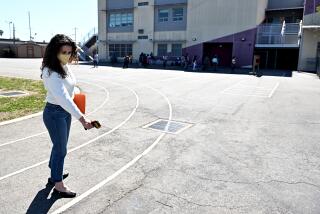Schools Find Themselves in in Quandary : Education: If it uses state funds to make repairs, the Pleasant Valley District would lose developer fees.
Camarilloâs elementary school district is slated to get $5.2 million to fix leaky ceilings, replace corroded plumbing and make other improvements at half a dozen schools that were built more than 30 years ago.
But school officials may not take the money.
Under the stateâs school-modernization program, the Pleasant Valley Elementary School District would have to give the state all of the fees the district gets from local developers during the period it receives state funding for renovating schools.
Pleasant Valley school officials estimate it would take two years to complete the modernization of their six oldest schools.
And during those two years, the district would have to turn over to the state the estimated $700,000 it would receive from local developers.
âIn order to gain some, weâd have to lose some,â school board President Ricardo Amador said.
But Amador and other district officials said they may not be able to afford giving up any developer fees because they are earmarked for repayment of the districtâs construction loan for the new Woodcreek Road school. To accept the state aid, the district would have find another way to meet the loan obligation.
Assistant Supt. Howard Hamilton said âitâs a blessing and itâs a curseâ to get state school-modernization funds. However, he said, âThere would be no question in our minds if it werenât for Woodcreek.â
Earlier this year, the school board agreed to take out $3.5 million in âcertificates of participation,â which are issued to investors like bonds, for building the new school.
To repay the certificates over the next 25 years, the district committed to paying $355,000 annually from its developer fees.
If Pleasant Valley takes the modernization money, the state would not allow the district to use it to repay the certificates, Hamilton said.
The school board could dip into its $1-million construction reserve fund to make the annual payments, but district officials have said they want to maintain the reserve as a hedge against years when developer fees, which are based on new construction, fall short of the needed $355,000.
The school board will consider whether to accept the modernization funds at its meeting June 29.
âIt would be a shame not to seeâ the funds accepted, board member Dolores (Val) Rains said. âItâs not just that itâs a lot of money, but the need is there.â
The six schools slated for renovation were all built between the 1940s and early 1960s, Hamilton said. They are Camarillo Heights, El Rancho, Las Posas, Los Altos, Los Primeros and Santa Rosa.
Although fresh coats of paint and other routine maintenance have kept the buildings from appearing dilapidated, the electrical wiring inside the walls and the plumbing under the floors is inadequate and unsafe, school officials said.
To remind people just how bad the plumbing is at Camarillo Heights, Principal Gerry Hamer has an exhibit in the school office of a piece of corroded pipe, which he has labeled âpiposaurus.â
Hamer retrieved the pipe last fall after it burst underground, shooting a 20-foot-high geyser onto the schoolyard.
Luckily, the schoolâs water was shut off only 1 1/2 hours because the broken pipe was at the far end of the buildingâs plumbing, allowing it to be easily repaired.
If the board rejects the state aid, school officials have said they would try to find other ways to pay for the repairs, such as a bond issue. Camarillo voters have twice narrowly defeated two proposed bond issues.
More to Read
Sign up for Essential California
The most important California stories and recommendations in your inbox every morning.
You may occasionally receive promotional content from the Los Angeles Times.










